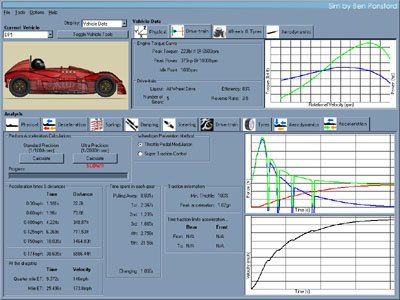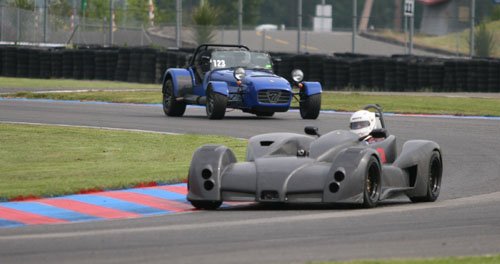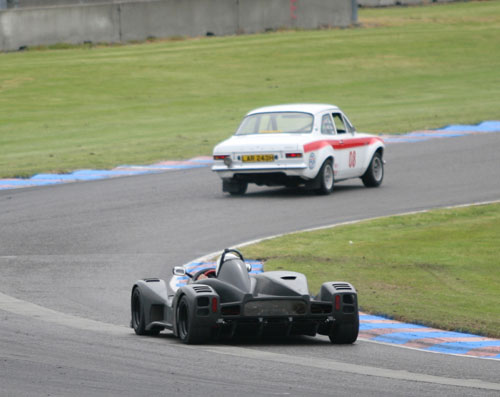|
SPEED With only about two pounds for each of the 400+ horsepower of its custom 3.0L V8, the power/weight ratio matches that of a modern Indy car. The chassis squeezes over 1.5g cornering from DOT-legal performance tires. And that's before downforce kicks in. A proprietary lightweight AWD system delivers the power to the ground. Many enthusiasts are familiar with the concept of a Traction Circle, defining a car's abilites to generate g forces in all directions - braking, cornering and acceleration. Except that in most cars the Traction Circle is not really a circle. The O is really a D with acceleration typically falling far short of the other abilites. Besides the lack of power, there is usually a lack of traction to use even whatever power that is there, relying on electronics to keep tires from spinning helplessly. The dp1 addresses both these issues. With power and traction that facilitate acceleration of over 1.5g it matches mechanical (non-downforce) cornering and braking. A perfect circle. It is my personal definition of well-rounded performance. To match dp1's potential, a million-dollar Bugatti Veyron supercar would need around 2,000 horsepower and 3-foot-wide tires! Read below for a detailed explanation of this claim. Advanced simulations indicate 0-60 mph time of around 2.0 sec and 0-100 mph time around 4.2 sec for the dp1. These numbers are almost identical to a Formula1 car. Click the image for a larger version showing a sample sim result. When shopping for a performance car one is faced with a wide range of choices. For example one can readily buy a 500hp four-door sedan or even a 1,000 hp supercar if money is no object. But which cars actually deliver real-world performance? Have you wondered why so few exotics ever show up at trackdays, and why those that do often get passed by much 'lesser' cars? Having driven a wide variety of cars on the track and having ridden in a number of supercars (F40, F50, Enzo, Carrera GT, Ford GT) in the hands of experienced track drivers I have made some interesting discoveries about what makes a car perform. My subjective impressions are backed by extensive GPS datalogging both with me and other people driving. I've also discovered that on the street, even a boxy 105 hp Scion xB is too fast if used to full capability. So when I talk about perfomance it's only worth talking about performance on a racetrack where a vehicle's abilities can be fully explored. To go fast, take it to the track.
What I have found is that real-world performance cannot be usefully predicted by absolute numbers like horsepower rating. Rather, there are several key ratios that affect how fast a car is going to be on a particular track. Some tracks will favor one aspect or another, but if a car can be optimized in every respect then it will perform well no matter what type of track it's on. The dp1 is the result of this analysis and has been designed to optimize every important performance aspect: Power/Weight, Power/Drag, Power/Traction and Tire/Weight By looking at the factors that affect real-world performance and optimizing all of them, the dp1 offers potential perfomance that is unmatched by anything short of top-level dedicated racecars such as LMP prototypes. Until now, only a few elite professional racers have experienced such speed. The dp1 puts this performance within reach of a dedicated trackday enthusiast.
|


